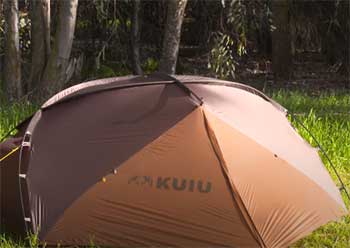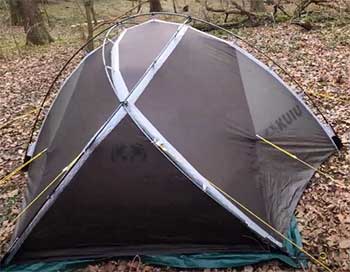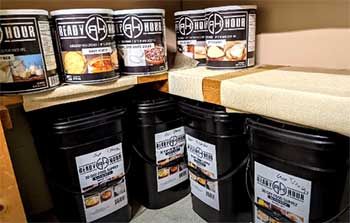The tents KUIU Mountain Star and Storm Star are a tad difficult to distinguish when placed next to one another. The similarities between them are considerable. But they are also known to be quite different from one another.
There are key differences that base our preferences. For instance, one is a better option to get for snowy conditions, their weights, what is the number of seasons they are usable for, and more.
A Quick Comparison Table
| Specifications | KUIU Mountain Star | KUIU Storm Star |
| Seasons | 3-seasons | 4-seasons |
| Wind handling | Can handle slight wind | Can handle strong wind |
| Snow handling | Can handle moderate snow | Can handle strong snow |
| Weight | 3.3 lbs | 5 lbs |
| Setup | Easy and fast | Less quick in comparison |
| Pricing | Less | More |
| Room | 1.4m by 1.2m | 1.4m by 2.2m |
Key Differences Between KUIU Mountain Star And KUIU Storm Star
- Seasons

3-season tents are what the Mountain Star is categorized as.
It is recognizably sturdier than most 3-season tents.
This model is an impressive tent given its stability and toughness and a great choice for a 3-season tent.
Most tents are three-season, which means they aren’t designed for usage in cold weather.
The Storm Star is a 4-season tent that can be used throughout the year, including the winter when heavy winds and snow are common.
These are composed of more durable materials, are taller inside to keep snow and water out, and are low to the ground so they don’t catch the wind.
Also Read: Is Kelty Tents Better Than Coleman Tents?
- Wind Handling
Withstanding moderate amounts of wind KUIU Mountain Star performs admirably. The thin floor would easily rip because it is not designed to withstand strong winds.
The tent is constructed as a cutting-edge ultra-quiet fleece to resist more than just the cold.
Wind Pro has a tight-knit fabric construction to prevent wind chill while staying air permeable, so this does not imply it cannot withstand the wind at all.
But if you’re going to be exposed to a lot of wind, the Storm Star is a better option.
Storm Star has a vestibule pole that crosses and two intersecting hoop poles. The stability and structural integrity of these poles are maximized in the face of the strongest winds and storms.
Once set up, the tent is stable and hardly moves. This keeps the tent from being loudly shaken by the wind and keeps you from obtaining a restful night’s sleep.
- Snow Handling
Mountain Star is capable of handling moderate snow while Storm Star can handle stronger conditions of snow. It can further withstand condensation.
The Storm Star’s inside is made of 30D material that has been treated with DWR so that water will bead off the surface rather than sink in, keeping you dry.
At the top of the tent, two ventilation points are strategically placed to reduce condensation.
It can be closed with the interior zipper if the weather changes and you get pounded with snow.
Its groundsheet is made of a foot-deep 40D ripstop. This ensures that the tent will keep them dry in a reasonable amount of snow.
- Weight
Mountain Star weighs less than Storm Star. Storm Star weighs more in comparison but in general, is lightweight for a 4-season tent.
In fact, it is lightweight enough to take any place and reliable enough to rely on in a remote location without a backup.
- Setup
In terms of setup, the Mountain Star tent tested was the quickest. The combined fly and tent with external clipping poles are the cause.

Therefore, the pole attaches on the outside, pitching both the fly and the body in one, as opposed to erecting the tent first and then draping the fly over top.
The asymmetric design makes it easier
Laying out the tent flat and fastening the tent’s corners for the Storm Star are the first steps in the setup.
The three poles consist of a center pole and two additional identical poles that fit into holes that are designated by color.
The poles also come with a repair sleeve, which is a thoughtful addition.
There is no longer any doubt about which pole goes where because the poles are slid into the proper color-coded corners.
Although setting up the rules is required for extremely windy situations, you don’t need to follow them if they aren’t predicted.
Also Read: Differences Between Cabela’s Alaskan Guide And Instinct Tent.
- Pricing
In the case of pricing, the Mountain Star is more affordable.
Regardless, these tents are better bought based on the requirement. Even though there is a difference in price, it depends on what conditions your tent will be exposed to.
- Room
You may argue that the Mountain Star’s shoulder room feels typical for its class. It is built for sleeping shoulder to shoulder and tapers from 1.4m by 1.2m.
Although there isn’t much room inside for gear, each vestibule is large enough to hold a pack in its entirety.
The Storm Star has an overall external footprint that is 2.2 by 2.7 meters. The inside space is 1.4 by 2.2 meters.
Conclusion
It is quite clear that from the comparison of KUIU Mountain Star and Storm Star, the latter comes out as the superior product. But keep in mind, as emphasized quite much in the article that your purchase depends on your requirement.
Both tents are star products in their respective and 4 season categories. As long you get your priorities right, either is a great purchase.

